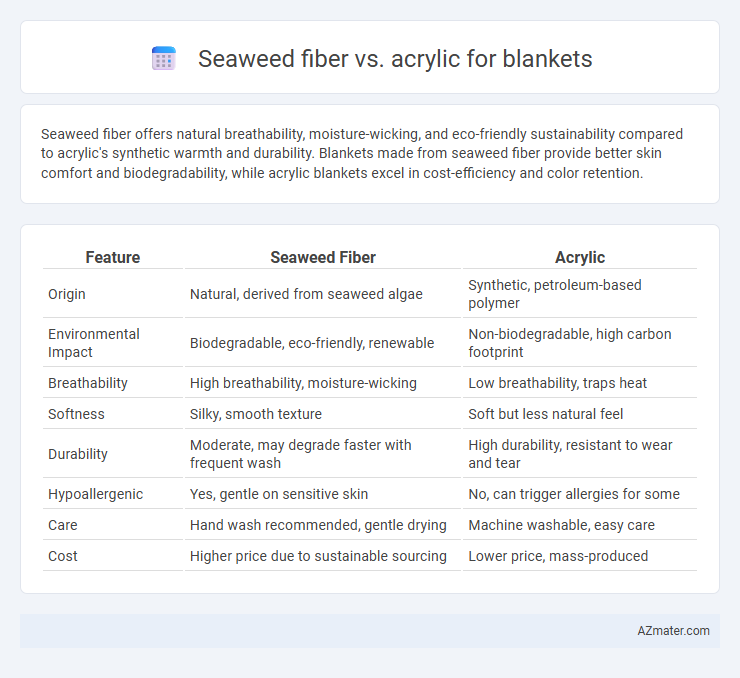Seaweed fiber offers natural breathability, moisture-wicking, and eco-friendly sustainability compared to acrylic's synthetic warmth and durability. Blankets made from seaweed fiber provide better skin comfort and biodegradability, while acrylic blankets excel in cost-efficiency and color retention.
Table of Comparison
| Feature | Seaweed Fiber | Acrylic |
|---|---|---|
| Origin | Natural, derived from seaweed algae | Synthetic, petroleum-based polymer |
| Environmental Impact | Biodegradable, eco-friendly, renewable | Non-biodegradable, high carbon footprint |
| Breathability | High breathability, moisture-wicking | Low breathability, traps heat |
| Softness | Silky, smooth texture | Soft but less natural feel |
| Durability | Moderate, may degrade faster with frequent wash | High durability, resistant to wear and tear |
| Hypoallergenic | Yes, gentle on sensitive skin | No, can trigger allergies for some |
| Care | Hand wash recommended, gentle drying | Machine washable, easy care |
| Cost | Higher price due to sustainable sourcing | Lower price, mass-produced |
Introduction to Seaweed Fiber and Acrylic Blankets
Seaweed fiber blankets are made from eco-friendly, biodegradable materials derived from marine algae, offering natural moisture-wicking and antibacterial properties that enhance comfort and sustainability. Acrylic blankets, composed of synthetic polymers, provide durability, vibrant color retention, and hypoallergenic benefits but lack the environmental advantages of seaweed fibers. Choosing between seaweed fiber and acrylic blankets depends on preferences for eco-consciousness versus synthetic durability and maintenance.
Source and Sustainability of Materials
Seaweed fiber is derived from renewable marine algae, making it a highly sustainable and biodegradable material with minimal environmental impact during harvest. Acrylic, on the other hand, is a synthetic fiber produced from petroleum-based chemicals, relying on non-renewable resources and often associated with higher energy consumption and pollution. The eco-friendly nature of seaweed fiber offers a significant advantage in sustainability compared to the fossil fuel-dependent acrylic used in blankets.
Manufacturing Process Overview
Seaweed fiber blankets are produced through a sustainable manufacturing process that involves extracting fibers from seaweed, blending them with natural materials like organic cotton, and then spinning the mixture into yarn before weaving or knitting. In contrast, acrylic blankets are made from petrochemical derivatives, where polymerization creates synthetic fibers that are extruded into filaments and then processed into yarns for textile production. The seaweed fiber process emphasizes eco-friendly practices and renewability, while acrylic manufacturing relies heavily on fossil fuels and involves more energy-intensive chemical processing.
Comfort, Softness, and Feel
Seaweed fiber blankets offer exceptional breathability and moisture-wicking properties, making them cooler and more comfortable for sensitive skin compared to acrylic options. The natural fibers provide a silky softness and a lightweight feel that enhances overall coziness, whereas acrylic tends to feel heavier and sometimes less breathable. Seaweed fiber's biodegradability also makes it a sustainable choice without compromising softness or comfort.
Thermal Insulation and Warmth
Seaweed fiber blankets offer superior thermal insulation due to their natural moisture-wicking properties and breathable structure, which help regulate body temperature efficiently. Acrylic fibers, while lightweight and durable, tend to retain heat without allowing adequate airflow, sometimes causing overheating during extended use. The eco-friendly, hypoallergenic nature of seaweed fiber also enhances comfort by maintaining warmth without trapping excessive sweat or heat.
Moisture Management and Breathability
Seaweed fiber offers superior moisture management by naturally absorbing and releasing sweat, keeping the skin dry and comfortable, whereas acrylic tends to trap moisture, leading to a clammy feeling. The breathable structure of seaweed fabric enhances airflow, promoting better temperature regulation compared to acrylic's denser synthetic composition. For blankets, seaweed fiber provides a more comfortable, fresh experience due to its eco-friendly, moisture-wicking, and breathable properties.
Durability and Lifespan
Seaweed fiber blankets offer exceptional durability due to their natural strength and resistance to wear, maintaining softness and integrity even after multiple washes. Acrylic blankets provide good durability but tend to pill and lose shape faster with frequent use, reducing their overall lifespan. Seaweed fiber's biodegradability also ensures prolonged quality without synthetic degradation, making it a longer-lasting eco-friendly alternative.
Allergenicity and Skin Sensitivity
Seaweed fiber blankets exhibit hypoallergenic properties, making them ideal for sensitive skin and reducing the risk of irritation or allergic reactions compared to acrylic fibers. Seaweed fibers contain natural minerals like iodine and potassium, which offer soothing benefits and promote skin health. Acrylic blankets often trap heat and moisture, potentially aggravating skin conditions and increasing allergen exposure, unsuitable for individuals with sensitive or allergy-prone skin.
Environmental Impact and Biodegradability
Seaweed fiber blankets offer a sustainable alternative to acrylic, as seaweed is a renewable resource that requires minimal water and energy for cultivation. Unlike acrylic, which is derived from petroleum and contributes to microplastic pollution, seaweed fiber is biodegradable and breaks down naturally without harming ecosystems. Choosing seaweed fiber over acrylic reduces carbon footprint and supports eco-friendly textile practices.
Price Comparison and Market Availability
Seaweed fiber blankets typically have a higher price point due to their eco-friendly production and limited market availability, making them a premium choice for sustainable consumers. Acrylic blankets are widely available in various retail outlets at a lower cost, benefiting from mass production and synthetic materials. Buyers seeking affordability and easy access often prefer acrylic, while those prioritizing natural fiber and environmental impact invest in seaweed fiber despite its higher price.

Infographic: Seaweed fiber vs Acrylic for Blanket
 azmater.com
azmater.com